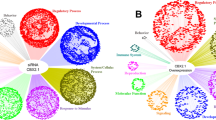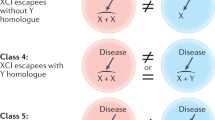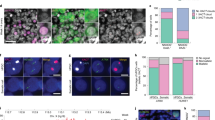Abstract
Male to female sex reversal has been observed in individuals with duplications of the short arm of the X chromosome. Here we demonstrate that sex reversal results from the presence of two active copies of an Xp locus rather than from its rearrangement and that alterations at this locus constitute one of the causes of sex reversal in individuals with a normal 46,XY karyotype. We have named this locus DSS (Dosage Sensitive Sex reversal) and localized it to a 160 kilobase region of chromosome Xp21, adjacent to the adrenal hypoplasia congenita locus. The identification of male individuals deleted for DSS suggests that this locus is not required for testis differentiation. We propose that DSS has a role in ovarian development and/or functions as a link between ovary and testis formation.
This is a preview of subscription content, access via your institution
Access options
Subscribe to this journal
Receive 12 print issues and online access
$209.00 per year
only $17.42 per issue
Buy this article
- Purchase on Springer Link
- Instant access to full article PDF
Prices may be subject to local taxes which are calculated during checkout
Similar content being viewed by others
References
German, J. et al. Genetically determined sex-reversal in 46,XY humans. Science 202, 53–56 (1978).
Fechner, P.Y. et al. Report of a kindred with X-linked (or autosomal dominant sex-limited) 46,XY partial gonadal dysgenesis. J. Clin. endocrinol. Methabol. 76, 1248–1252 (1993).
Bernstein, R. et al. Female phenotype and multiple abnormalities in sibs with a Y chromosome and partial X chromosome duplication: H-Y antigen and Xg blood group findings. J. med. Genet. 17, 291–300 (1980).
Scherer, G. et al. Duplication of an Xp segment that Includes the ZFX locus causes sex inversion in man. Hum. Genet. 81, 291–294 (1989).
Stern, H.J., Garrity, A.M., Saal, H.M., Wangsa, D. & Disteche, C.M. Duplication Xp21 and sex reversal: Insight into the mechanism of sex determination. Am. J. hum. Genet. 47, suppl, A41 (1990).
May, K.M., Grinzaid, K.A. & Blackston, R.D. Sex reversal and multiple abnormalities due to abnormal segregation of t(X;16)(p11.4;p13.3). Am. J. hum. Genet. 49, suppl, 19 (1991).
Ogata, T. et al. Sex reversal in a child with a 46, X, Yp+ karyotype: support for the existence of a gene(s), located in distal Xp, Involved in testis formation. J. med. Genet. 29, 226–230 (1992).
Narahara, K., Kodama, Y., Kimura, S. & Kimoto, H. Probable inverted tandem duplication of Xp in a 46,Xp+ boy. Jap. J. hum. Genet. 24, 105–110 (1979).
Nielsen, K.B. & Langjaer, F. Inherited partial X chromosome duplication in a mentally retarded male. J. med. Genet. 19, 222–236 (1982).
Bardoni, B. et al. Functional disomy of Xp22-pter in three males carrying a portion of Xp translocated to Yq. Hum. Genet. 91, 333–338 (1993).
Worley, K.C. et al. Identification of three new markers in Xp21 between DXS28(C7) and DMD. Genomics 13, 957–961 (1992).
Worley, K.C. et al. Yeast artificial chromosome cloning in the glycerol klnase and adrenal hypoplasia congenita region of Xp21. Genomics 16, 407–416 (1993).
Walker, A.P. et al. A YAC contig in Xp21 containing the adrenal hypoplasia congenita and glycerol kinase deficiency genes. Hum. molec. Genet. 1, 579–585 (1992).
McKusick, V.A. in Mendelian Inheritance in Man 10th edn 1841–1843 (Johns Hopkins University Press, Baltimore, 1992).
Berkovitz, G.D. et al. Clinical and pathologic spectrum of 46,XY gonadal dysgenesis: its relevance to the understanding of sex differentiation. Medicine 70, 375–384 (1991).
Berta, P. et al. Genetic evidence equating SRY and the testis-determining factor. Nature 348, 448–450 (1990).
Harley, V.R. et al. DNA binding activity of recombinant SRY from normal males and XY females. Science 255, 453–456 (1992).
Hastie, N.D. Dominant negative mutations In the Wilms tumor (WT1) gene causes Denys-Drash syndrome: proof that a tumor suppressor gene plays a crucial role in normal genitourinary development. Hum. molec. Genet. 1, 293–295 (1992).
McCabe, E.R.B., Towbin, J.A., van der Engh, G. & Trask, B.J. Xp21 contiguous gene syndromes: deletion quantltation with bivariate flow karyotyping allows mapping of patient breakpoints. Am. J. hum. Genet. 51, 1277–1285 (1992).
Dutrillaux, B. & Viegas-Pequinot, E. High resolution R-and-G-banding on the same preparation. Hum. Genet. 57, 93–95 (1981).
Sambrook, J., Fritsch, E.F. & Maniatis, T. in Molecular Cloning: A Laboratory Manual (Cold Spring Harbor Laboratory Press, New York, 1989).
Bardoni, B., Guioli, S., Maserati, E., Maraschio, P. & Camerino, G. A highly conserved sequence on the short arm of chromosome 7 detects multiple polymorphisms. Hum. Genet. 81, 23–25 (1988).
Franco, B. et al. A gene deleted in Kallmann's syndrome shares homology with neural cell adhesion and axonal path-finding molecules. Nature 353, 529–536 (1991).
Schaefer, L. et al. A high resolution map of the human Xp22 region. Nature Genet. 4, 272–279 (1993).
Schlessinger, D., Mandel, J.-L., Monaco, A.P., Nelson, D.L. & Willard, H.F. Report of the fourth international workshop on human X chromosome mapping 1993. Citog. and Cell Genet. 64, 148–194 (1993).
Author information
Authors and Affiliations
Rights and permissions
About this article
Cite this article
Bardoni, B., Zanaria, E., Guioli, S. et al. A dosage sensitive locus at chromosome Xp21 is involved in male to female sex reversal. Nat Genet 7, 497–501 (1994). https://doi.org/10.1038/ng0894-497
Issue Date:
DOI: https://doi.org/10.1038/ng0894-497
This article is cited by
-
Sexual determination in zebrafish
Cellular and Molecular Life Sciences (2022)
-
Mammalian X-chromosome inactivation: proposed role in suppression of the male programme in genetic females
Journal of Genetics (2022)
-
Leydig Cell–Specific DAX1-Deleted Mice Has Higher Testosterone Level in the Testis During Pubertal Development
Reproductive Sciences (2022)
-
Genetische Grundlagen bei Varianten der Geschlechtsentwicklung
Gynäkologische Endokrinologie (2021)
-
Gene dosage of DAX-1, determining in sexual differentiation: duplication of DAX-1 in two sisters with gonadal dysgenesis
Molecular Biology Reports (2019)



